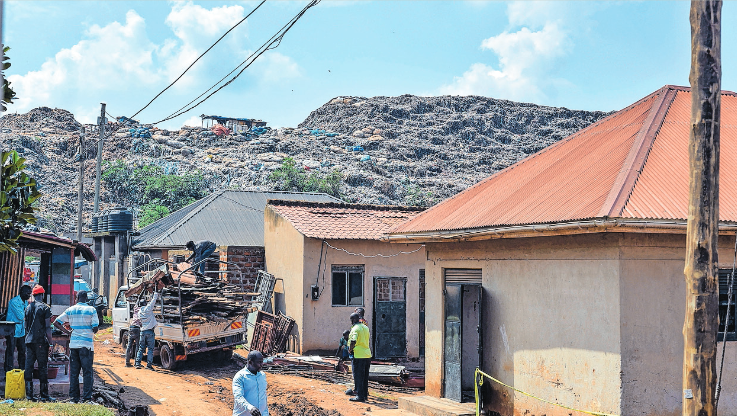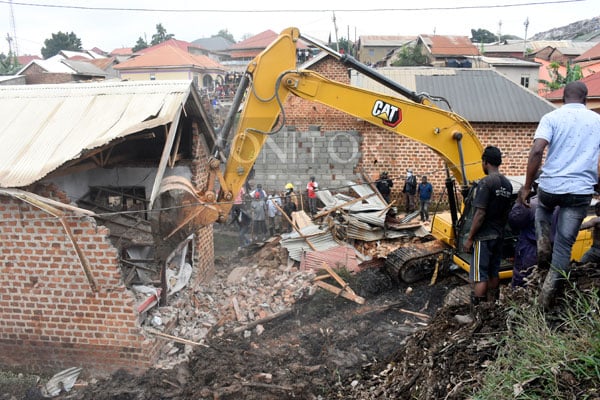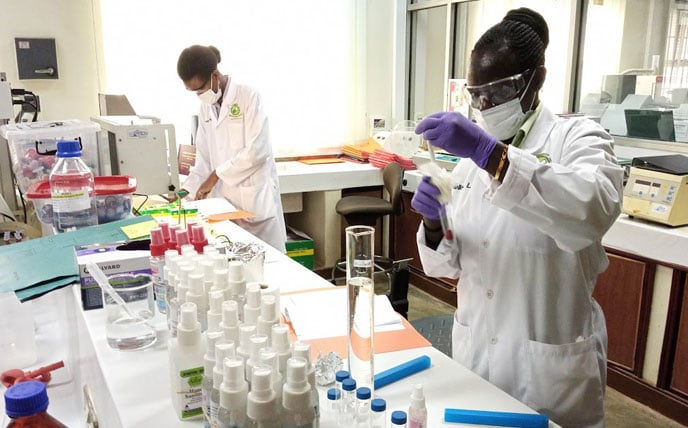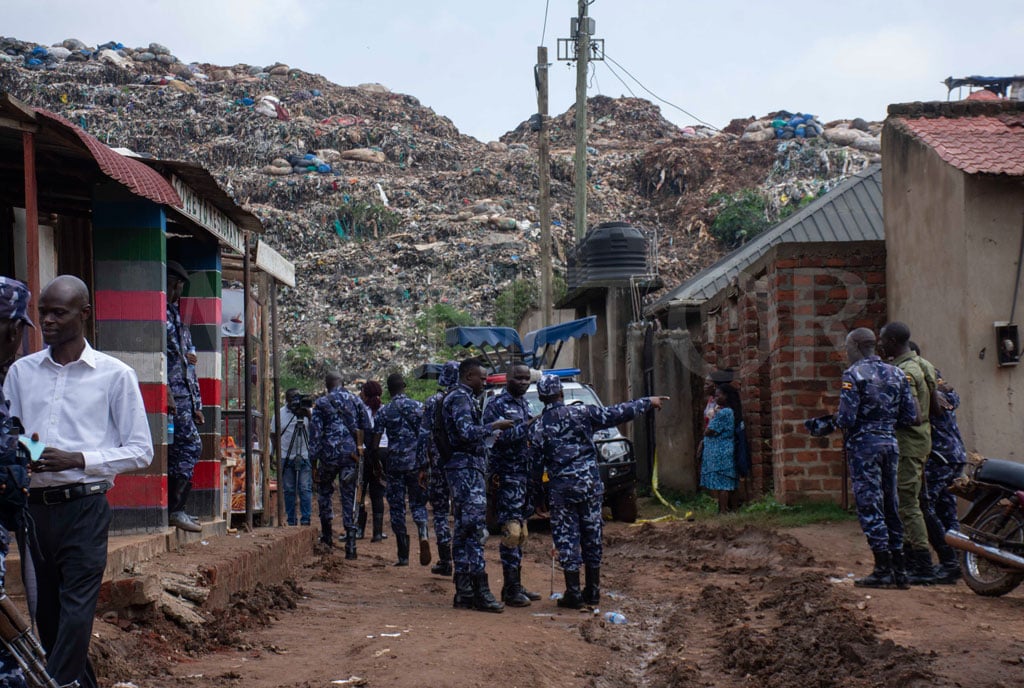
Security officers are seen at the Kiteezi dumpsite in Wakiso District on August 13, 2024, in the aftermath of a trash collapse that left at least 34 people dead. PHOTO/ISAAC KASAMANI
On October 4, the Electricity Regulatory Authority (ERA) published in this newspaper a “notice of intended application for licence” for the development of the proposed 20 Megawatts waste-to-energy power plant in Ddundu Village in Kyampisi Sub-county, Mukono District.
The notice, a prelude to securing a permit for feasibility study, followed a meeting on July 25, by executives of ERA, Uganda Electricity Transmission Company Ltd (UETCL), KCCA, and the investor, Vida Energy Uganda Ltd, to fast-track the power plant project midwifed in State House late last year.
Last October, President Museveni met with executives of a Spanish-based company, Ric Sun Investments S.L, specialising in photovoltaic projects, about developing the waste-to-energy plant. The meeting and the proposal, knowledgeable sources told Monitor, came against a backdrop of the years-long plan to urgently decommission the Kiteezi landfill that had filled beyond capacity and operationalise a new landfill at Ddundu where KCCA, in 2016, acquired 135 acres.
The development of Ddundu had run into strong headwinds of resistance from area residents and budgetary constraints. On the other hand KCCA, according to inside accounts and documents seen by this newspaper, required Shs36b to decommission Kiteezi.
The Committee on Commissions, Statutory Authorities and State Enterprises (Cosase) report released last week on the Auditor General’s audited accounts of KCCA detailed that the entity included this money in the Budget Framework Papers but the Ministerial Policy statements reflected it as an unfunded priority.
The request for Shs36b is detailed in KCCA’s budgets among the unfunded priorities during the financial year 2019/20, 2020/21, 2021/22, 2022/23, 2023/24, and 2024/25. The Cosase report recommended that the Ministry of Finance Permanent Secretary, Mr Ramathan Ggoobi, and the ministers of Kampala, who are the political supervisors of KCCA, should similarly be held accountable for the Kiteezi accident on August 10 that killed 34 people and injured 21 others.
During the meeting on October 19 last year, also attended by Finance minister Matia Kasaija, his counterpart for energy Ruth Nankabirwa, then KCCA executive director Dorothy Kisaka and her Director of Public Health, Dr Daniel Okello, developing Ddundu and decommissioning Kiteezi was the key agenda.

Former KCCA executive director Dorothy Kisaka, ex-deputy director David Luyimbazi and ex-director health services Dr Daniel Okello in the dock at Kasangati Chief Magistrate's Court in Wakiso District where they appeared on October 18, 2024. PHOTO/ABUBAKER LUBOWA
According to insiders, Ric Sun Investments S.L and their local partners Vida Energy Uganda Ltd, were granted permission on October 20 to start work “immediately” owing to the exigency posed by Kiteezi. Since 1996 when it was gazetted as a landfill, Kampala’s population— estimated at around 774,241 as per the 1991 census, 1.1 million in 2022, 1.4 million in 2014, and 1.8 million as per the 2024 census—has been expanding as is the city’s boundaries, meaning more waste pressure.
In recent history, according to documents seen by Monitor, the first warning of the landfill spilling beyond its buffer zone was recorded in 2015 although there were no fatalities.
ALSO READ: Kiteezi: An accident or criminal negligence
There was another alert last year in November following the heavy rains the month before. A more serious warning was raised in January this year, which was flagged during the KCCA’s executive committee and subsequently to the Ministry of Kampala and the parliamentary Committee on Presidential Affairs, which scrutinises budgets of the latter.
Sleeping on the job
The state minister for Kampala Affairs, Mr Kabuye Kyofatogabye, said the technical team led by Ms Kisaka “hid information” from him.
“Could I have raised more money if I had known early, yes. But I didn’t know. I am telling you nothing but the truth I didn’t know about it (imminent danger) until it happened. That is when I saw a memo,” Mr Kyofatogabye said, further accusing the political leadership at City Hall of having “misled” Ms Kisaka down the drain.
On November 1, President Museveni directed KCCA to proceed with the waste-to-energy power plant plans that would process 1,000 tonnes of waste per day into electricity.
From December, the Ric Sun Investments S.L/Vida Energy joint venture engaged back and forth with KCCA on the $100m (about Shs364b), culminating in the July meeting that led to the submission of the notice on August 2, with hopes of securing permit for feasibility study before September 30; start on a proper evacuation study by end of this month; environment impact assessment and sign power purchase agreement with UETCL by November 15; and submit application for licence to ERA before January 10, 2025. ERA went mute in August.
ERA’s director for Corporate and Consumer Affairs, Mr Julius Wandera, defended that the October 4 notice was published within the statutory timeline.
“The review of Vida's application was completed within our licensing SOPs (standard operating procedures) timeliness. The application is, however, undergoing further due diligence with KCCA, basically to obtain formal confirmation from KCCA in granting the applicant access to the waste,” Mr Wandera said.
Documents seen by this newspaper show that for almost a decade now KCCA had been flaunting the idea of the waste-to-power plan as a blueprint for the city’s waste crisis that has since spilt over into the newly created cities.
Mr Kyofatogabye acknowledged that there were more than 100 companies that expressed interest in the venture, but the capital investment was high.
“Most of them were talking about investing $100m (about Shs364b). They were also requesting sovereign guarantees, but we said no to this; companies had misused these guarantees, where they would go to get the money and then disappear leaving the debt on the government books,” he said.

Ms Minsa Kabanda, the minister for Kampala and Metropolitan Affairs (right) and her junior Kabuye Kyofatogabye at a recent function. PHOTO | JOCYLYNNE NAKIBUULE
Amid the Ric Sun Investments S.L/Vida Energy—KCCA back and forth, tenderpreneurs, recently swept in the corruption sweep at State House, in May this year introduced to the President another company China National Electric Engineering Co. Ltd, also proposing to develop and finance Shs364b waste-to-power plant at Ddundu. The company even proposed a lower tariff of seven cents from processing 1,500 tonnes of waste, compared to Ric Sun Investments S.L/Vida Energy’s 15 cents. The Chinese firm’s proposal was forwarded to the Attorney General and KCCA for review but sources indicated that during ongoing discussions, the tariff had inched past 20 cents.
As plans to operationalise the Ddundu site vacillated, it is apparent that key actors in government were aware of the clear and present danger posed by Kiteezi. Mr Kyofatogabye defended that the onus fell on Ms Kisaka and her team to show how imminent the danger was. He also criticised the Cosase probe, which called for several officials to be held culpable, saying it was “myopic.”
Anatomy of a tragedy
The Kampala Lord Mayor, Mr Erias Lukwago, acknowledged that they had, since 2011, flagged the imminent danger several times.
“In 2021, when we got a report by Queensland and Leeds Consulting Engineers in association with Air Water Earth recommending the closure of Kiteezi not later than October 2023, we summarised it and tabled it before Council, unfortunately it was not discussed. But other than tabling the reports on the same, what did the minister want me to do?” Mr Lukwago wondered.
He added: “I chaired several budget meetings where we asked for money to decommission Kiteezi, but always we were told there is no money.”
Between 2022 and 2024 when KCCA’s pleas for Shs36b to decommission Kiteezi were suppressed by Parliament, which appropriates funds, Parliament paid out Shs1.7b as a service award to its Commissioners and former Leader of Opposition, doled out Shs3b on buying luxury cars for former Speakers of Parliament, and bailed out

Leader of Opposition in Parliament Joel Ssenyonyi and members of the shadow cabinet gesture after they were barred from accessing the Roko Construction company premises in Kawempe, Kampala on October 14, 2024. PHOTO/COURTESY/OMUNAKU ALINA PLAN
with Shs253b, among others.
In the aftermath of the landfill spilling beyond its buffer zone on August 10, sources told Monitor that President Museveni paraded Ms Kisaka and her deputy Luyimbazi before Cabinet to explain the slow implementation of his April 2023 directive on waste disposal by urban authorities and the urgent operationalisation of the alternative landfill at Ddundu.
In the same vein the President also directed the Inspector General of Government (IGG), Ms Beti Kamya, to inquire into the circumstances leading to the Kiteezi accident. Upon receiving the probe report, the President on September 24 fired Ms Kisaka, Mr Luyimbazi, and Dr Okello in the public interest “due to significant evidence of criminal negligence.”
“The IGG’s report clearly outlined the severe oversight and negligence exhibited by these officials,” State House noted in a statement, further directing the Criminal Investigations Department (CID) to look into the matter “focusing on the angle of criminal negligence associated” with the landfill collapse upon which the three officials were summoned on October 16, detained, charged, and eventually remanded on October 18.
While the charging of the former KCCA top executives was welcomed as a step in the right direction to ensure accountability, a string of events and document trail indicate that the accident could have been prevented had the powers that be, across the Executive and Parliament, acted both judiciously and on time. But power fights, non-prioritisation, underhand methods, and schemes of political expediency over a period of 10 years, carried the day, resulting in the tragedy.
These revelations also raise questions as to who exactly bears the responsibility for failing the people of Kiteezi, and to what degree. Ms Kisaka and her co-accused have denied all charges.
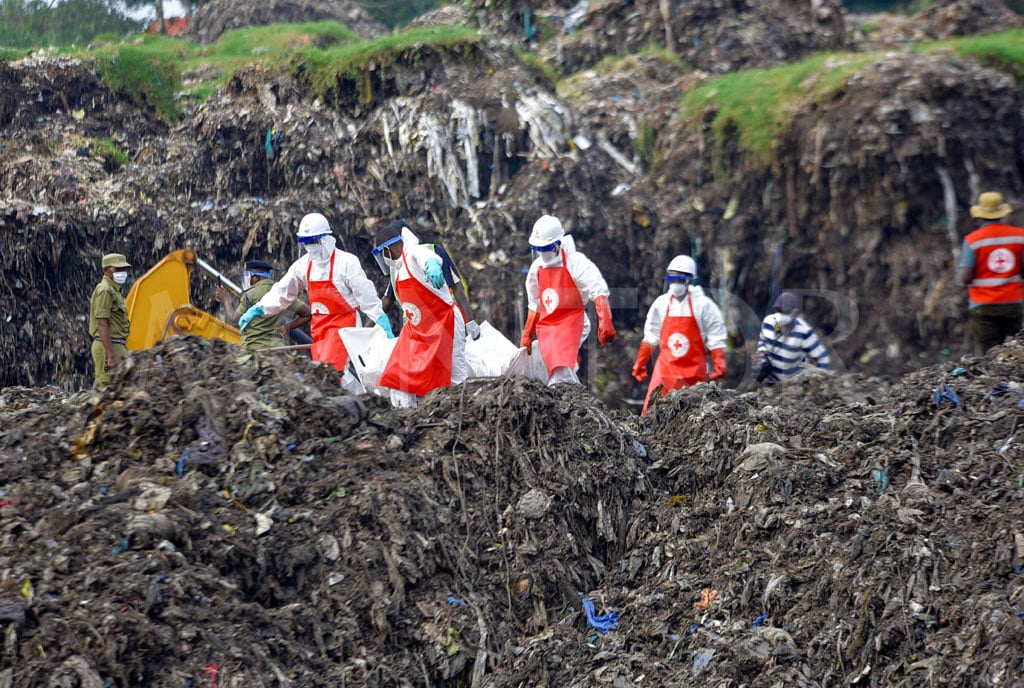
Members of the Safe and Dignified burial team from the Uganda Red Cross Society carry a body that was recovered from Kiteezi landfill garbage on August 14, 2024. PHOTO/MICHAEL KAKUMIRIZI
The Kiteezi landfill was established in 1996 to handle waste from Kampala and the neighbouring towns of Nansana, Kiira and Kasangati.
There are reports that the National Environment Management Authority (Nema) in 2013 and 2020 declined to renew the Kiteezi operating licence on account of the depleted operational area. KCCA was then led by Ms Jennifer Musisi.
This newspaper, however, has seen documents that Nema did not decommission Kiteezi per se. Rather, the body in December 2020 tasked KCCA to submit “concrete plans clearly indicating the measures that will be put in place to ensure that Kiteezi waste disposal site is improved to address the associated risks and impacts on human health and environment.”
Omission, laxity, both?
In a March 2, 2021, brief, KCCA submitted these plans to Nema, charting undertaking feasibility studies and sourcing funds from the government for decommissioning and related works, with future plans of operationalising Ddundu.
“It is imperative that we get support from both Nema and the Ministry of Finance for KCCA to meet the plans laid out,” the brief reads in part. On the other hand, Ddundu area residents had rejected part of their village being turned into dumpsite for waste generated 40km away, leaving Kiteezi as the only option.
“The continued use of the Kiteezi stretched its capacity,” the Cosase report detailed.
Both Mr Lukwago and Mr Kyofatogabye concurred with the Cosase findings. The duo, whose offices complement the day-to-day running of city affairs, however denied direct responsibility but instead pointed fingers at each other.
“In 2013, I was not here, and I tried to find out what happened, but I was getting scanty information. I have had questions about what the ministry has done. We have raised all this, to Parliament, and to the Ministry of Finance during the budgeting processes, and there was no money. So, what do you do?” Mr Kyofatogabye said.
KCCA severally requested funds from the Ministry of Finance to embark on decommissioning the site but was met with stalling. The Cosase report pinned Mr Ggoobi for “keeping quiet” upon receiving Ms Kisaka’s request on June 23, 2023, for Shs36b to decommission Kiteezi.
“The landfill has exceeded its design capacity, and the current operations are not optimised to facilitate materials and resources recovery, adequate leachate treatment and pollution control, and efficient utilisation of space,” Ms Kisaka’s letter, also copied to the Minister for Kampala Minsa Kabanda and the chairperson of the parliamentary Budget Committee, reads in part.
According to the Cosase report, Ms Kabanda, as KCCA’s political supervisor, too, “took no action”—neither visited the dumpsite to appreciate the gravity of the crisis nor raised the matter in Cabinet, let alone following up with the Ministry of Finance.
“The minister and PSST cannot escape liability for what befell the country,” the Cosase report noted.
The report further detailed that “for a long period the government has been reluctant to respond to KCCA's pleas for resources to establish a modern plant and equipment leading to over-utilisation of the Kiteezi landfill beyond its design capacity.”
Mr Kyofatogabye said the technical team hid information from him.
“Shockingly, the Shs4.1b was out to Shs3.1b planned. We continued to do what we could do. The technical team is paying for their sins. The technical team hid from me that the hill could collapse, and I concentrated on the flooding, and I directed the compensation of the affected and they left. I didn’t know. All we have been seeing is that we need money to decommission Kiteezi, to operationalise Ddundu. If they had told me, I would have done something. Until it happened is when I saw that memo.”
He added: “They were now two in one with Lukwago. The problem is Lukwago; he is selfish and envious. Just because you hate the party in government. They are now getting political capital from all this. Lukwago has been the political head of the city since 2011.”
Documents seen by this newspaper details that City Hall spent Shs4b as “operational costs” for Kiteezi, spending an estimated $4,850 (Shs17.6m) per tonne of waste. The Shs4b was spent on among others; Shs2.5m on hiring an excavator daily yielding an annual cost of Shs930m; Shs2.5m spent on two excavators employed during rainy seasons and emergencies for at least 180 days, totalling Shs458m, among others.
Back and forth
In the June 20 letter to Mr Ggoobi, Ms Kisaka detailed Shs235b as the capital expenditure of developing Ddundu and Shs19.4b was annual operational costs. The spread out cost per tonne of waste was estimated at Shs17,860 ($4.6) plus an operational cost of Shs16,700 ($4.3) per tonne.
“If KCCA is to maintain its annual spend close to current levels, it will require a viability gap funding grant of Shs175.5b ($47m) split between the construction phase and the operational phases over a period of 15 years which is the conservative estimated lifespan of the Ddundu processing site,” she wrote.
She added: “KCCA is thus proposing budgetary support from the Ministry of Finance for the upfront capital costs and operational costs for the initial five-year period linked to reforms in waste management and stepped down over a period as Greater Kampala Metropolitan Area (GKM) KCCA’s local revenue resource improves.”
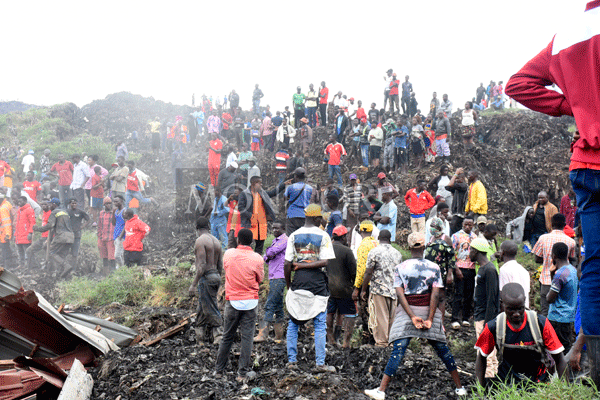
Residents gathered at Kiteezi landfill where a heap of garbage fell on houses and livestock on August 10, 2024. PHOTOS/ ISAAC KASAMANI
Earlier in 2021 and 2022, KCCA engaged the Uganda Development Bank and the Ministry of Finance’s Public Private Partnership (PPP) unit about the possibility of financing the Ddundu plant directly or as a partnership, respectively, but proposals were unsuccessful. Mr Lukwago, on the other hand, said their years-long request for funds to decommission Kiteezi is on record and they wait to see if anyone in the Executive will be held accountable.
“We wait to see the action going to be taken against the two ministers for Kampala, and the PSST for being culpable. It would not be fair if we apply double standards, that you cause prosecution of the technical team and leave the other side,” Mr Lukwago said.
He said he raised concerns about possible misuse of the Shs4b for management of Kiteezi annually and proper accountability was not always furnished.
“If the money was meant to flatten the garbage, what explains the existence of those mountains of garbage…The accounting officer and her deputy refused to halt the processes and they continued spending the money there and the place was in a total mess? To that extent they are accountable,” he said.
A 2021 study by M/s Queensland and Leeds Consulting Engineers in association with Air Water Earth (AWE) recommended the closure of Kiteezi no later than October 2023. Separately, a November 2021 KCCA technical feasibility study concluded that Kiteezi was operating beyond capacity and that the slopes of the waste mountain were geotechnically unstable, thus posing an imminent risk of a waste slide.
A September 2022 environment impact assessment financed by the UKAID also recommended urgent closure of Kiteezi. A December 2022 social impact assessment co-financed by the World Banks IFC and UKAID, recommended setting aside funds address the socio-economic impacts on communities dependent on the landfill.
The February 2023, GKM solid waste management strategy highlighted the urgent closure of Kiteezi and the need to operationalise new waste disposal sites. The Auditor General, in 2023, reported that Kiteezi was overfilled, rendering it hazardous to public health, and further reflagged the absence of a buffer zone to protect the neighbouring community.
Tragedy strikes
The last warning came 40 days before the calamity. In a July 2 memo to Ms Kisaka and Mr Luyimbazi, Dr Okello reflagged the emergency situation at the landfill consisting of the developing cracks and waste movement, blocked drainage channel and depleted operational area. He further highlighted the potential consequences of "no immediate interventions,” including waste slides or landfill collapse which could be dangerous to people and damage property.
The back and forth and blame game between KCCA and its supervising Ministry of Kampala has also affected short-term interventions, including the closure of the landfill, stabilisation of the slopes and improving drainage.
While no more garbage is being taken to the landfill and some drainage channels have successfully been opened after months of flooding, the slopes of the garbage mountain remain a danger.
Conclusion
Like in the Kiteezi case more than two months ago, last Tuesday’s fuel tanker explosion at Kigogwa Town on the Kampala-Bombo Road that killed 17 people and injured 21 others, hospitalised at Kiruddu hospital yet again, albeit fleetingly, reawakened national consciousness about one of Uganda’s commonplace problems: loaded fuel tankers squeezing in passenger traffic on the narrow potholed roads, and petrol stations and depots spotted haphazardly in residential and industrial hubs. Until 1994, Uganda had six licensed fuel retailers, namely UPET, GAPCO, Shell, Agip, Total and Caltex but the liberalisation of the market brought on board more players, currently more than 100. As of September 2021, according to the Ministry of Energy, there were 1,258 licensed fuel stations.

State Minister for ICT and National Guidance Godfrey Baluku Kabbyanga (left) and his counterpart for Luweero Triangle Alice Kaboyo (2nd left) hand over a casket bearing the remains of Isaac Ssebuliba to his relatives at the City Mortuary in Kampala on October 27, 2024. PHOTO/ ISAAC KASAMANI
There is also a long list of unlicensed retailers across the country, according to the standards body, Uganda National Bureau of Standards (UNBS) guidelines, a fuel station must be at least 1,000 metres away from another. Human settlement should be 15 metres away but this is often disreagrded. Whenever such accidents happen, we move on so fast until the next tragedy strikes, then start panicking.

